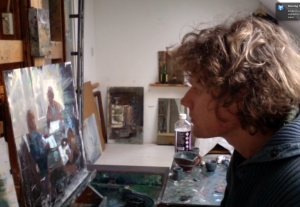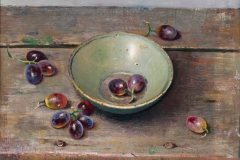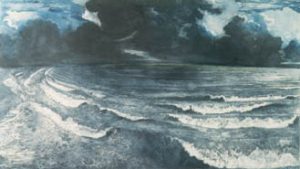Interview
Simeon Nijenhuis (1969, Zaandijk, The Netherlands) graduated in 1993 in fine arts, drawing, and graphics at Academy Minerva in Groningen. He became known for his series of large etchings of cathedrals. From 1999 on he concentrated on painting in oils.
A still life of a Chinese dish with grapes is on display in the studio of Simeon Nijenhuis. ‘They are one of my favorite subjects; grapes are so beautifully delicate and transparent.’
Everywhere on display in the studio are still lifes. ‘Even though to some I will not admit, I’m rather impulsive. If I have an idea, I immediately want to know what it looks like. So I’m often working on ten paintings at the same time.’
‘I started painting around ’99. That was somewhat surprising fore people who knew me from my etchings. But I’m fairly cyclically inclined: something keeps me non-stop working for a time, then there is usually something new. When I was doing my etching of the sea, I visited the exhibition ‘Praise of maritime navigation’ in (museum) Boymans and there the idea occurred to go painting. For I realized that with a subject like the sea, I did not get there with the linear approach of etching. Those soft gray tones of the 17th century Sea painters I found incredible. That was what I wanted!’
…those soft gray tones of the 17th century Sea painters I found incredible…
‘At first I tried with color etchings, but that was a tragedy. At the academy, I never had painted or concerned myself about color. And color is a complicated thing, not something you can do right away. Yet I found that you occasionally have to change course drastically if you want to stay fresh and inspired. After years of having done etchings I was becoming faint of all that fussing and bustle of lines. I wanted a kind of calm in my work.’
‘At an opening in Utrecht someone once said to me: Your work is so vital and dynamic, almost aggressive. But in a few years you won’t make these things anymore. He was right. As you get older you once in a while want to create something within where is silence. This is possible with oil, because you can paint beautiful surfaces, that in addition to the dynamics, ensure calmness.’
‘What I first did was make some study. To Florence, Paris, New York. Watching the old masters. I frantically ran through the Louvre, to Van Gogh, Chardin, Corot. I sucked everything to me, especially color.’
‘When I actually started painting I knew one thing for sure: I would not be another neo-impressionist. I was aiming for the depths of the 17th-century masters. Many contemporary artists use colors to seduce immediately. A blue against a bright red. The Jan Cremer palette that is omnipresent. I love colors that bear a mystery. That soft color transitions of a painter like Claesz Heda move me tremendously. A good painting should evoke a mood for me.’
‘In the 20th century the painting became a concept, an illustration of an idea. What I want is a painting to become an experience again. A painting must ‘live’. touch your senses. If you look at a painting of chestnuts, you should be able to smell the autumn. To comply, I had to believe myself quite to my own standards. Hundreds of studies I made. Always you research something else. It was not just to get to master the technique, but also to develop a vision. So search topics, collect objects. Find what suits you. Only then will you get the magical mix between technology and vision.’

Simeon in his studio
‘Actually, I’m a bit stuck in the still life. It was intended as a study, but I’ve gotten hooked. My work has changed dramatically: from the enormity of cathedrals to the intimacy of three grapes in a Chinese dish. But the reality is hugely fascinating; the color of yellowed pages, the shine of leather.’
‘But before you can make a painting that is truly spacious, there must flow a lot of water to the sea. What I learned gradually, is that certain laws in the painting can not relax on your boot. Precisely to express your own personality, you need to understand a few general rules. Often contemporary painters are too cocky, you see always the same uniformity. When I was at an exhibition of the Royal Grant, I looked through my eyelashes, and all I saw was brownish areas on the walls. While these painters were so busy to stop their ‘own’ me in their paintings. But if you go Terborch, Van Mieris and Vermeer, you get them yet easily apart. While they rely on the same schemes and themes. Fascinating isn’t it? In this way, Simeon Nijenhuis paintings evolve. I don’t care too much, do not specifically sail a course of uniqueness. I find it fun to get to work with themes that I encounter here and in painting. Painted Floris Verster a bowl in 1900, Dick Ket painted it in 1930, Jan van Tongeren in 1960, and I paint it now.’
‘That gives me a good feeling. Art is also a bit of folklore. For someone like me, born in ’69, to be original, is to ask for neurotic randomness. What you get is all kinds of far-fetched nonsense. We all love to be unique, but we are very similar. Art is in my mind about what unites us, not about what divides us.’
‘Now I’m painting in good stride. I get more and more momentum and spaciousness in my work. And I’m learning every day.’

